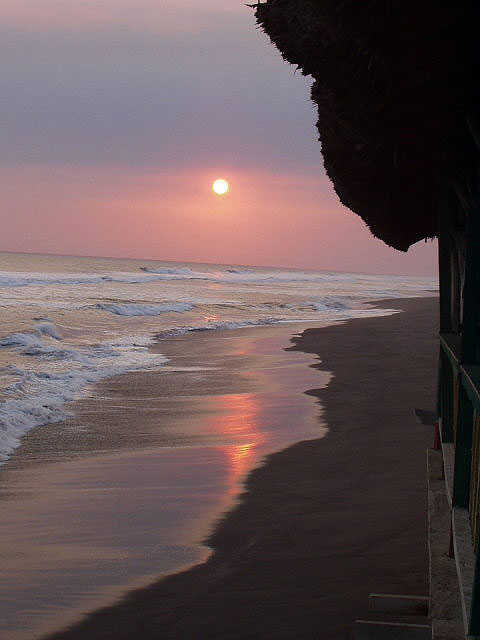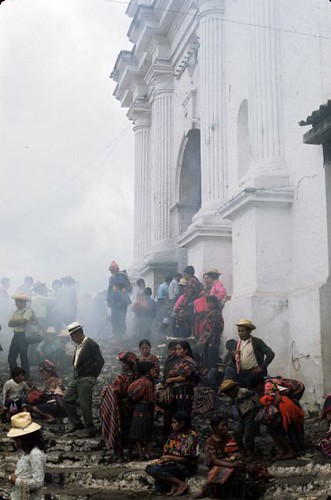I went to the market today, and I had an interesting linguistic experience. I usually talk to the people in Spanish, though I know a lot of them speak Kaqchikel (I think I need to learn the numbers better before attempting market Kaqchikel. Either that or all my purchases need to be less than 20 quetzales). A lot of the workers are pre-teen or teenage boys, oddly enough. So I asked one about something, and he asked his friends about it Kaqchikel. I know there's been some risk of the language dying out because people don't always speak it at home, although there has been a resurgence of Mayan culture, language, religion, etc. recently. Maybe it's too much to generalize from food and dress, but it seems like typically in Guatemalan Mayan culture, the women are the ones who preserve traditions more frequently or diligently. So I feel like the fact that teenage males were speaking it is a good sign that it's not dying out. And, I could understand some of what they were saying.
This week I started with my new teacher. I guess I'd have to say that it's been less than ideal. She doesn't have as much pedagogical experience as my previous instructors, so it's not really a well-structured class, and she hasn't gone through the PLFM's training program. This is an issue because Kaqchikel has just been starting to be standardized in the last 10 years, so there are a lot of variations among different towns, but the PLFM teaches them how to teach standard Kaqchikel. So pretty soon into the first day, I realized that something was up because her verb tenses were not how I learned in the past: they were more confusing and not regulated. (For the linguists out there, I learned later that some of it is actually from Spanish's influence on the language - like to form the future, she sticks the verb for "to go" in the middle of the verb after the time and subject/object prefixes and before the root, so it's like ir + a + infinitive). So, things like that made it a little frustrating, but we ending up doing a lot of conversation, so I figured that at least it was good practice.
Though we also had some pedagogical issues. Like there were times when we just sit at our table, not doing anything. Not talking, not writing, just sitting and staring. Seriously. Then she would say something along the lines of I already know so much that she doesn't know what to teach me, so what do I want to learn? Not exactly a question that a student can answer easily.
But today a (at least temporary) solution seems to have cropped up. The group of students from Tulane are at the same school where I am, having their class. The directors of the program invited my teacher and I to sit in, so today we went, and it was tons of fun. They use really great pedagogical methods that I like (our beloved communicative approach, TPR, etc.) Like today they were doing commands with intransitive verbs, so we all worked as a class and had to tell each other things like "Sing!" "Stand Up!" "Dance!" "Swim!", then we broke into small groups, then we cam back together and did present tense intransitive verbs. All communicatively, in Kaqchikel, no Spanish at all (which is how I like it). It was all things I already knew, but it helped me quite a bit to reinforce it. And in our small groups the Tulane-group teacher could tell I knew more, so she started having me do other things (like instead of having me repeat saying things like "I sit" which I already knew, she taught me how to say "I am seated," which was great because it tied together a couple of things I had been reading in my grammar book, and it really clicked).
After the session, I went up to the director who invited us and thanked him and said I really liked the class. My teacher asked if we could join their class for the next couple of days, and he said sure. I think my teacher liked it as much as I did because it was fun, and because honestly, I think she has no idea what to do with me.
So, the good thing about this Tulane class is that a lot of the academics that are working in Guatemala (in history, anthropology, linguistics, etc.) are associated with this program. So it really helps me make connections with them. The bad thing is that I already know most of what we're doing, so I'm not really advancing, although I am becoming more confident with what I already know. There IS an advanced group that goes off on their own for a couple of hours, but so far I haven't managed to break that ice.
But it any case, it's better than what I had the past two days, and I hope it'll help me more career-wise.
Time to sign off and go back to the house because it's...
Latin American Idol time!! (Yes, it's exactly the same but with Spanish-speakers).









